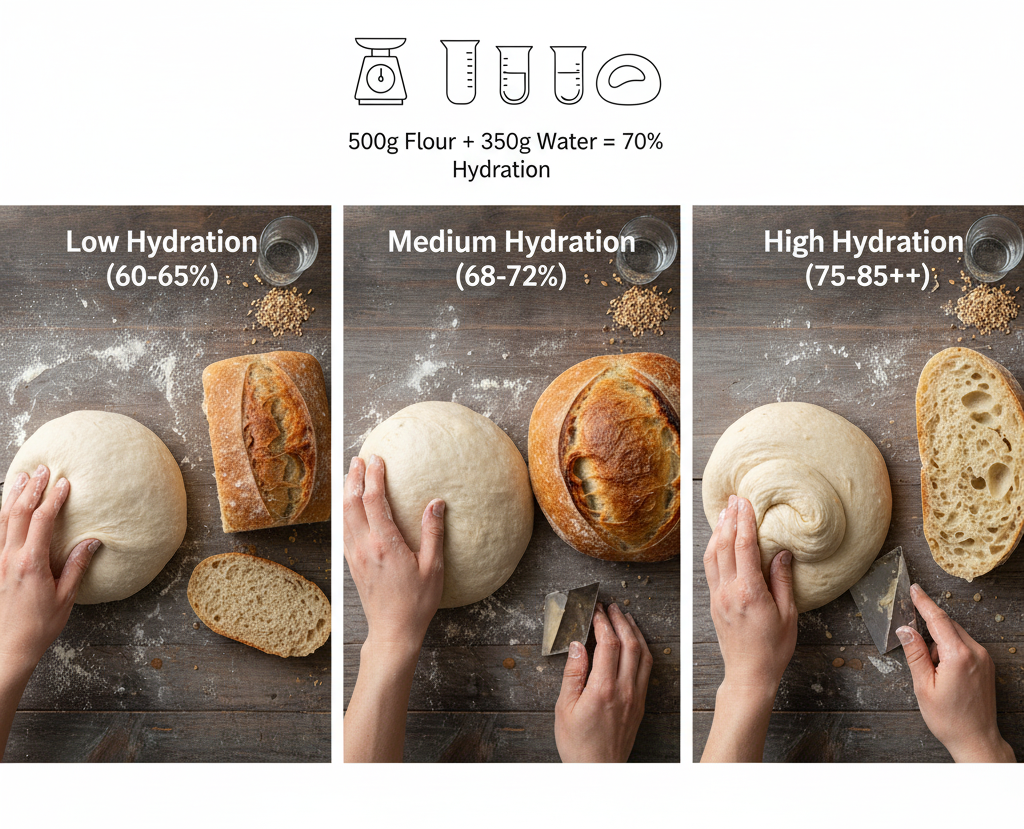Learn how sourdough hydration levels affect sourdough bread. Discover the differences between low, medium, and high hydration doughs, plus tips for handling sticky dough like a pro.

How to Properly Hydrate Your Sourdough
Sourdough hydration sounds technical, but it’s simply the ratio of water to flour in your dough. Get it right, and you’ll bake bread with the texture and crumb you want. Get it wrong, and you’ll fight sticky messes or dry loaves.
This guide breaks hydration down into easy-to-understand levels — with tips, tricks, and handling techniques that actually work in a home kitchen.
What Is Sourdough Hydration?
Hydration is expressed as a percentage. For example:
- 500g flour + 350g water = 70% hydration.
The higher the percentage, the wetter the dough. Hydration influences:
- Fermentation speed (higher hydration → faster).
- Crumb structure (lower → tighter, higher → open).
- Handling difficulty (lower = easier, higher = stickier).
Hydration Levels Explained
Low Hydration (60–65%)
- Dough feels firm and easy to shape.
- Produces tighter crumb, great for sandwiches.
- Less chance of overproofing.
Best for beginners learning dough strength.
Medium Hydration (68–72%)
- Balanced: extensible but not too sticky.
- Open crumb with good chew.
- Great “everyday sourdough” level.
This is the sweet spot for most bakers.
High Hydration (75–85%+)
- Very sticky and slack.
- Bakes up with big holes and custardy crumb.
- Requires strong gluten development (stretch & folds, coil folds).
Great for ciabatta, focaccia, or rustic boules.
How to Handle Sticky High-Hydration Dough
Don’t panic if your dough feels like glue. Try these cheats:
- Wet hands before touching the dough.
- Use a dough scraper instead of your fingers.
- Do more coil folds to build strength.
- Cold retard (fridge proof) → dough is easier to shape when chilled.
Choosing the Right Hydration for Your Bake
- Want an airy crumb with big holes? Go 75%+.
- Need sandwich-friendly slices? Stick to 65%.
- Baking in a cool kitchen? Higher hydration helps fermentation move faster.
- Using whole wheat or rye? Hydration needs to be higher (they absorb more water).
FAQ
Q: What hydration is best for beginners?
A: Start with 65–68%. It’s easy to handle while still giving you a nice open crumb.
Q: Does higher hydration make bread taste better?
A: Not necessarily. Higher hydration changes the texture and crumb, but flavor comes more from fermentation time and flour choice.
Q: Can I add more flour if my dough is too sticky?
A: It’s better to adjust at the start. Midway through fermentation, adding flour can throw off the balance. Instead, chill the dough or use wet hands to manage stickiness.
Final Thoughts
Hydration is one of the biggest levers you can pull to control your sourdough. Think of it as a dial: lower hydration for structure and control, higher hydration for wild, open-crumb loaves. With practice, you’ll know exactly where to set that dial for the bread you want.
Next read: Sourdough Proofing Guide to see how hydration ties into fermentation speed.